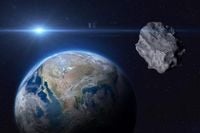In a scenario that feels ripped straight from the pages of science fiction, an asteroid with the ominous name 2024 YR4 is currently being watched by space agencies and scientists worldwide. According to a flurry of recent research, including a preprint paper published on September 15, 2025, by a team of over a dozen researchers—among them several NASA scientists—the asteroid has a 4.3% chance of colliding with the moon in December 2032. While that probability might seem low, the potential consequences have prompted serious debate about how humanity should respond.
Asteroid 2024 YR4 was first detected in December by the Asteroid Terrestrial-impact Last Alert System station in Chile. NASA estimates its diameter at approximately 220 feet—large enough to earn the moniker “city killer.” Although initial models suggested there was a 3% chance the asteroid could strike Earth, that risk has since been ruled out, shifting all eyes to the moon as the potential target. According to Discover Magazine, the asteroid’s lunar impact probability has climbed to about 4% as more data has become available.
But why does a possible collision with the moon matter so much? The answer lies in the potential fallout. The research paper, uploaded to arXiv and cited by NBC News, warns that a lunar impact could produce debris “up to 1,000 times above background levels over just a few days, possibly threatening astronauts and spacecraft” in low-Earth orbit. That means satellites, the International Space Station, and even future lunar missions could face unprecedented risks from a sudden spike in micrometeoroid activity.
The threat is serious enough that the researchers have outlined several possible responses, ranging from the dramatic to the more measured. One headline-grabbing option: deploying a nuclear device to obliterate the asteroid before it reaches the moon. This so-called “robust disruption” would involve blasting the space rock apart with one or two nuclear devices, ideally before it gets close enough to pose a threat. The paper states, “Nuclear robust disruption missions are also available, with launches between late 2029 and late 2031.” A second device would serve as a backup, just in case the first fails to do the job.
But as Julie Brisset, interim director of the Florida Space Institute, noted to NBC News, “If the explosion is not enough, you’re just going to create a debris field anyway.” And therein lies the rub: detonating a nuclear device in space has never been tried, and the risks are substantial. Not only could an insufficient explosion simply break the asteroid into smaller, equally dangerous pieces, but the resulting debris could still threaten satellites and astronauts.
Complicating matters further, scientists still know relatively little about the asteroid’s mass and composition—critical factors in determining how to deflect or destroy it. “Deflection missions were assessed and appear impractical,” the research team wrote, citing the lack of key information and the tight timeline. The best chance to learn more would be a reconnaissance mission, but as the paper notes, “The best reconnaissance mission options launch in late 2028, leaving only approximately three years for development.” That’s not a lot of time to design, build, and launch a mitigation mission, especially one involving nuclear technology.
NASA, for its part, is taking a cautious approach. Kelly Fast, the agency’s acting planetary defense officer, told NBC News that there are currently no plans to deflect or interfere with the asteroid. Instead, NASA will study 2024 YR4 early next year using the James Webb Space Telescope, hoping improved data will clarify the asteroid’s orbital path and potentially “drop the impact probability to 0%.” As Fast put it, “If observed, the additional data could improve our knowledge of where the asteroid will be in December 2032.”
Other non-nuclear options have been discussed as well, such as using a kinetic impactor—a spacecraft designed to crash into the asteroid and nudge it off course. NASA’s 2022 DART mission provided a successful proof of concept when it altered the trajectory of the asteroid Dimorphos, shortening its orbit by 33 minutes. However, as Brisset pointed out, a successful deflection would also require knowing the mass of 2024 YR4, which remains elusive.
Of course, there’s always the possibility of doing nothing. While an impact with the moon wouldn’t alter its orbit, it would create a fresh crater and send a shower of debris toward Earth. Most of that debris would burn up in the atmosphere, but the rest could increase the risk of micrometeoroid strikes on satellites and the International Space Station. The researchers argue that even if the probability of impact drops, “there is significant potential utility in deploying a reconnaissance mission to characterize the asteroid.”
Political and international considerations further complicate any intervention. Detonating a nuclear device in space, even for planetary defense, could stoke tensions in the ongoing space race, especially among the United States, China, and Russia. As Brisset mused, “It would probably be countries that have the technical capability to do it, which maybe narrows it down to three or four, but would they want to work together?” With China planning to land astronauts on the moon by 2030 and discussing the possibility of a lunar nuclear plant, and the United States eyeing regular lunar missions, the stakes for cooperation—or conflict—are high.
Meanwhile, NASA’s own priorities remain in flux amid significant budget pressures and shifting political winds. According to NBC News, President Donald Trump’s budget blueprint for NASA proposes slashing more than $6 billion from the agency’s funding, which could further complicate any ambitious planetary defense mission.
Looking ahead, the next major milestone will come in 2028, when asteroid 2024 YR4 makes its closest approach to the moon before the potential impact date. At that point, scientists expect to have a much clearer picture of whether a collision is truly likely. Until then, the debate continues: Should humanity risk the unknowns of nuclear disruption, attempt a kinetic nudge, or simply hope for the best?
Whatever the outcome, the story of asteroid 2024 YR4 is a stark reminder of how the cosmos can throw a curveball when we least expect it. With the clock ticking and the world watching, the decisions made in the coming years could set a precedent for how we defend our planet—and its celestial neighbor—from the unpredictable hazards of deep space.

